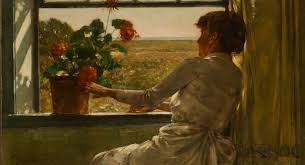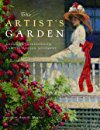Eye For Film >> Movies >> The Artist's Garden: American Impressionism (2017) Film Review
The Artist's Garden: American Impressionism
Reviewed by: Jennie Kermode

Last year, Exhibition On Screen released Painting The Modern Garden, a documentary that went behind the scenes of the exhibition of that name at the Royal Academy in London. This year, it's expanding on some of the ideas in that film with a look at the story behind The Artist’s Garden: American Impressionism And The Garden Movement, an exhibition which enjoyed considerable success at the Florence Griswold Museum in Connecticut. Although it's not a direct sequel, this new documentary in many ways picks up where the first left off, as it follows the adoption of Impressionist techniques by US artists and looks at the way this movement interacted with changing attitudes to gardens, as well as many other changes going on in US society at the time.
In the late 1800s, America was growing less interested in defining itself through internal conflicts and more focused on discovering its identity through the histories of its diverse population. this precipitated a great interest in things European, a getting an education is Europe, especially by spending time in Paris, became de rigeur for the privileged classes. With the work of Claude Monet dominating the Parisian cultural scene, it was perhaps no surprise that Impressionism would make its way across the Atlantic, but attempts to use its language to say something truly American were where it began to break away and transform into something unique. The natural relationship between this and the American landscape - natural and cultivated - forms the backbone of the film.

As the title of the Connecticut exhibition suggests, Florence Griswold's famous garden has a central role in the story as it's told here, thus complicating the narrative by separating the art of gardening from the art of painting and lending a different, more instinctive character to the former. There is less focus on individuals and more on movements as the film looks at the various painters who stayed at her retreat. There's significant amount of attention paid to female artists and to the different ways American painters depicted women (with shades of today's so-called Culture War), moving away from the child-like innocent, the demure lady and the muse to depict women in active roles, women educating themselves and women aware of the restrictions placed on their lives. It's no accident that this was also the period when US women won the right to exhibit and sell their work on the same basis as men, ceasing to be seen as amateur dabblers and tarting to make their creative voices heard.
The film mixes shots of paintings in the exhibition with footage of the places which inspired them, some of which have changed little since. Some excellent work is done blending the one into the other. Enthusiastic interviewees help to make the subject engaging and Gillian Anderson's narration is solid throughout. At its strongest when connecting artistic and social issues, this may never quite recapture the magic of its predecessor, but it's still a strong piece of work.
Reviewed on: 10 Mar 2017
















